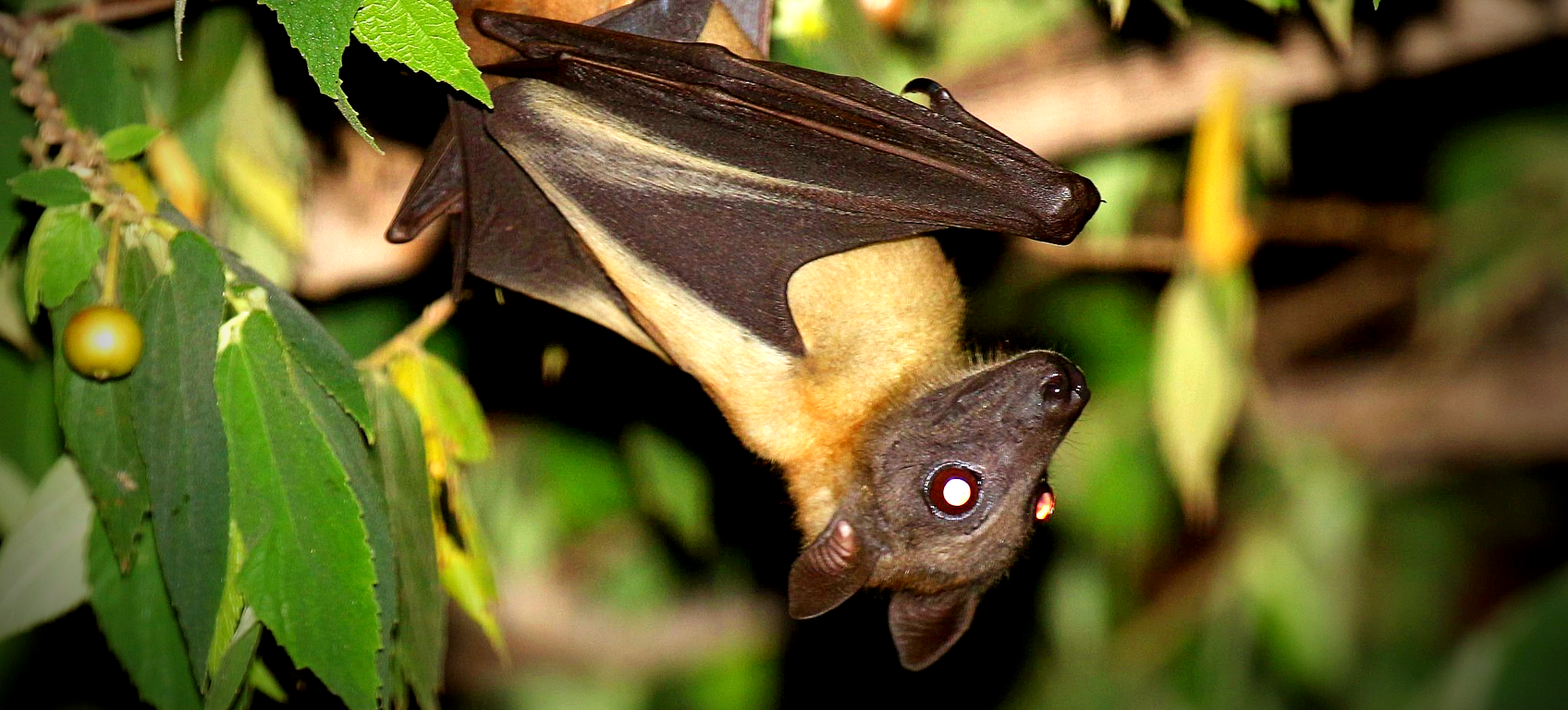Overview
The Egyptian Fruit Bat (Rousettus aegyptiacus) is a large Old World fruit bat known for its reliance on echolocation and acute vision to navigate in darkness. This species is distributed across parts of Africa and the Middle East, occupying a variety of habitats including forests, savannas, and caves. It is a crucial seed disperser and pollinator, playing a vital ecological role in the regeneration of tropical and subtropical vegetation. Egyptian Fruit Bats are gregarious and often roost in colonies numbering from a few dozen to several thousand individuals.
Their diet consists primarily of fruits such as figs, dates, and guavas, which they locate using a combination of eyesight and tongue-click echolocation. Unlike most fruit bats, they can emit audible clicks to aid in obstacle detection within cluttered environments like caves and dense canopies. They are nocturnal, leaving their roosts at dusk to forage over distances up to several kilometers. Despite their ecological importance, they are sometimes persecuted as agricultural pests in areas where they feed on commercial fruit crops.
This bat has a characteristic fox-like face with large eyes adapted for low-light vision and strong jaws designed to crush fruit pulp. Its wings are broad and leathery, allowing agile flight and hovering while feeding. Egyptian Fruit Bats breed throughout the year in equatorial regions but show seasonal peaks in reproduction further north. Their social behavior, diet, and reproductive strategies have made them a focus of scientific research in chiropteran ecology.
Taxonomy
Kingdom
Phylum
Class
Order
Family
Genus
Species
Type
Current distribution:
The Egyptian Fruit Bat ranges across much of sub-Saharan Africa, North Africa, and the Middle East. Countries of occurrence include Egypt, Sudan, Ethiopia, Kenya, Tanzania, Uganda, Israel, Saudi Arabia, Yemen, Oman, and Turkey. They are among the most widespread fruit bats in Africa and are also found on some islands of the eastern Mediterranean. Their distribution reflects their ability to exploit diverse habitats and fruit resources.
Local populations may experience seasonal fluctuations in abundance linked to rainfall and fruiting patterns. In some areas, such as Israel and Egypt, colonies have adapted to roosting in buildings and archaeological sites. While generally abundant, they are sometimes culled due to perceived conflicts with agriculture. Despite this, their overall conservation status remains secure.
Physical Description:
Egyptian Fruit Bats have a robust, furry body with a golden-brown to grayish dorsal pelage and paler underparts. Their head resembles that of a small dog or fox, with a pointed muzzle and large, dark eyes adapted to nocturnal activity. The ears are moderately long and lack a tragus, differentiating them from insectivorous bats. Their wings are long and broad, with a wingspan that can exceed two feet, providing excellent maneuverability.
The forearms and wing membranes are hairless and dark, contrasting with the lighter body fur. They have strong, clawed thumbs that help them climb and manipulate fruit. Their tongue is elongated and brush-tipped, enabling efficient feeding on nectar and pulp. Sexual dimorphism is minimal, though males may be slightly larger than females in some populations.

Lifespan: Wild: ~10 Years || Captivity: ~20 Years

Weight: Male: 4.9–6.3 oz (140–180 g) || Female: 4.6–6.0 oz (130–170 g)

Length: Male: 5.1–6.7 in (13–17 cm) || Female: 5.1–6.3 in (13–16 cm)

Height: Male: 3.9–4.7 in (10–12 cm) || Female: 3.5–4.3 in (9–11 cm)

Top Speed: 12 mph (19 km/h)
Characteristic:
Native Habitat:
Egyptian Fruit Bats inhabit diverse environments ranging from dry savannas and woodlands to moist tropical forests and rocky outcrops. They prefer areas with abundant fruit trees and suitable roosting sites such as caves, abandoned buildings, and mine shafts. Colonies often select warm, humid roosts that provide stable microclimates, which are essential for pup development. They are capable of adapting to human-altered landscapes where cultivated fruit trees are available.
Roosting colonies can number from a few dozen to thousands, with dense aggregations producing significant heat and humidity. In regions with seasonal rainfall, bats adjust their foraging patterns to follow fruiting cycles across different habitats. They are known to roost communally with other bat species in large cave systems. Their wide ecological tolerance contributes to their success across a broad geographic range.
Biogeographical Realms:
Countries:
Diet:
Diet & Feeding Habits:
Egyptian Fruit Bats are primarily frugivorous, consuming a wide range of soft, pulpy fruits that they process by masticating the flesh and spitting out the fibers. They show a strong preference for figs, dates, and cultivated fruits such as mangoes and guavas. Foraging usually occurs at night, when they travel considerable distances to locate ripe fruiting trees. They also supplement their diet with nectar and flowers, contributing to pollination.
The bats carry fruit back to feeding roosts where they consume the pulp, leaving behind seeds that aid in forest regeneration. Their digestive system is adapted to the rapid passage of fruit material, allowing them to consume large quantities relative to their body weight. Echolocation via tongue clicks enables them to avoid obstacles in complete darkness, a rare adaptation among fruit bats. Their diet varies seasonally depending on fruit availability and regional plant phenology.
Mating Behavior:
Mating Description:
Egyptian Fruit Bats exhibit a polygynous mating system, where dominant males defend territories within roosts to attract females. Breeding occurs year-round in equatorial regions but shows seasonal peaks in areas with marked wet and dry seasons. Females give birth to a single pup after a gestation period lasting approximately 105–120 days. The mother carries newborns for the first few weeks and is dependent on maternal milk for up to three months.
Mating behaviors include scent marking, vocalizations, and wing displays by males to court receptive females. Females may mate with multiple males within a colony, increasing genetic diversity. Males establish small territories within communal roosts, which they defend vigorously during the breeding season. Pups are capable of flight by about eight weeks of age but remain close to their mothers until fully weaned.
Reproduction Season:
Birth Type:
Pregnancy Duration:
Female Name:
Male Name:
Baby Name:
Social Structure Description:
Egyptian Fruit Bats are highly social, forming dense colonies that provide protection and thermoregulation. Within roosts, social bonds are maintained through grooming and vocal communication. Females often cluster together, especially during breeding and pup-rearing periods. Males may establish territories or harems within the colony during the mating season.
Colonies exhibit complex social dynamics, including dominance hierarchies and cooperative behaviors. Individuals recognize conspecifics through scent and vocal cues. Foraging can occur solitarily or in loosely associated groups depending on food availability. Roost fidelity is strong, with bats returning to the same sites year after year.
Groups:
Conservation Status:
Population Trend:
Egyptian Fruit Bats are abundant throughout their extensive range and are considered one of Africa’s most successful fruit bats. Their ability to thrive in both wild and urban environments has contributed to stable population levels. Colonies can grow rapidly where roosting sites and fruit resources are plentiful. Although locally impacted by culling and habitat disturbance, overall populations remain resilient.
Monitoring programs in the Middle East and Africa continue to assess their status due to the importance of these regions in disease ecology and agriculture. In some regions, bat populations have benefited from the spread of cultivated fruit trees. Colonies in urban and peri-urban settings can reach thousands of individuals. Their stable trend supports their classification as Least Concern by the IUCN.
Population Threats:
Key threats include persecution due to crop damage and fear of disease transmission. Large colonies are sometimes destroyed or disturbed by humans attempting to eradicate bats from buildings or caves. Habitat loss through deforestation and development reduces the availability of roosting and foraging sites. Additionally, they are occasionally hunted for bushmeat in parts of their range.
Pesticide exposure can contaminate food sources and harm reproductive success. Climate change and increased drought frequency may disrupt fruiting cycles, which are critical for sustaining colonies. Disturbance of maternity roosts during sensitive breeding periods can lead to pup mortality. Education and conflict mitigation measures are crucial in reducing persecution.
Conservation Efforts:
Egyptian Fruit Bats benefit indirectly from the protection of caves, forest reserves, and important roosting habitats. Some countries have implemented legal protections against indiscriminate killing, recognizing their ecological role. Research and public awareness campaigns highlight their contributions to pollination and seed dispersal. In areas of conflict with farmers, non-lethal deterrents and netting have been promoted as alternatives to culling.
Captive breeding programs support education and research into bat biology and zoonotic diseases, thereby enhancing our understanding of these important topics. Conservation organizations monitor colonies in sensitive or high-conflict zones to ensure sustainable coexistence. Community outreach emphasizes the benefits of bats to agriculture and ecosystem health. Ongoing research into bat ecology helps inform management strategies for this widely distributed species.
Additional Resources:
Fun Facts
- Egyptian Fruit Bats are among the few fruit bats that echolocate using tongue clicks.
- They can consume up to twice their body weight in fruit each night.
- Their strong jaws and molars are adapted to crush fruit pulp efficiently.
- They play a major role in dispersing the seeds of over 80 plant species.
- Their milk has higher fat content than that of most insectivorous bats.
- The species has been observed commuting over 10 km in a single foraging trip.
- In some cultures, their droppings are used as fertilizer due to their high nutrient content.
- They have excellent night vision, aided by large, sensitive eyes.
- Their roosting colonies can generate significant heat, raising temperatures in caves by several degrees.
- Despite myths, they do not suck blood and feed exclusively on fruit and nectar.














